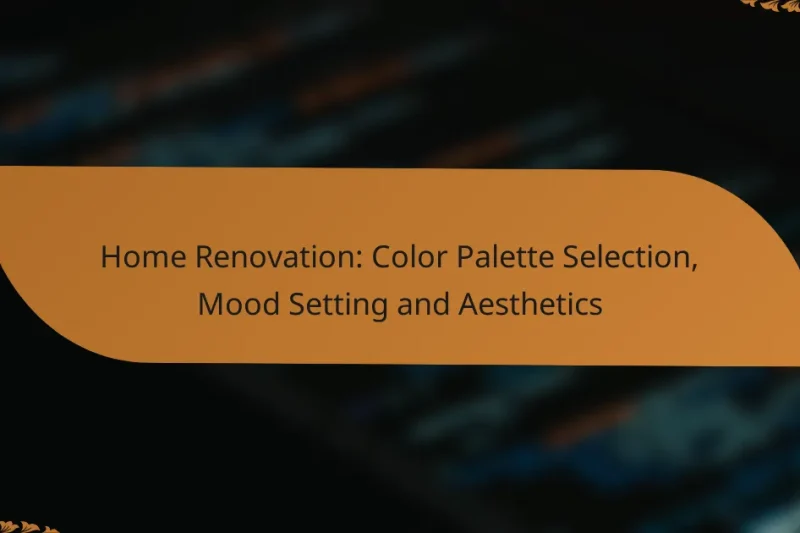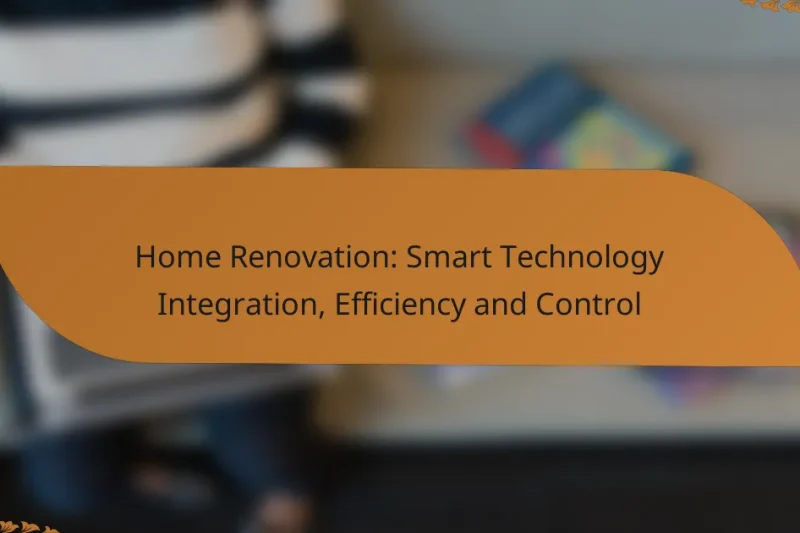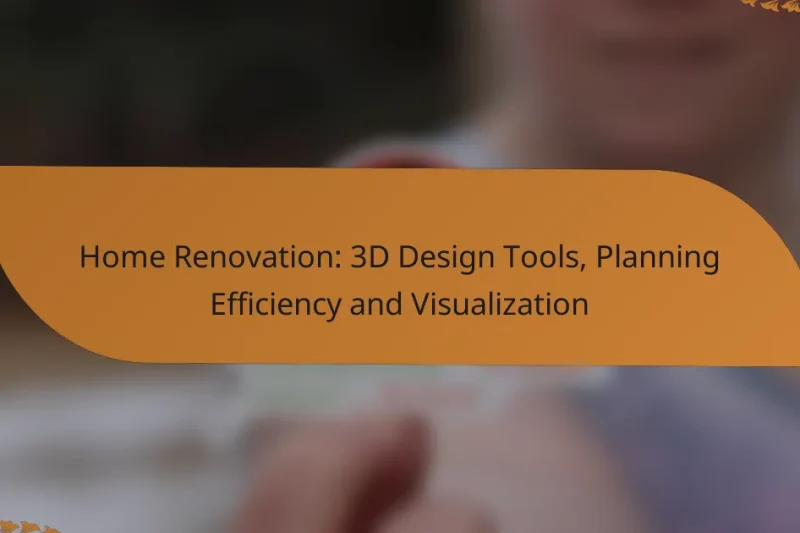Selecting the right color palette for home renovation is crucial for enhancing both functionality and aesthetics. … Home Renovation: Color Palette Selection, Mood Setting and AestheticsRead more
Home Renovation Design
Home renovation design in Los Angeles emphasizes maximizing space, sustainability, and the integration of modern technology. With trends like open floor plans and eco-friendly materials, homeowners can create functional and stylish living environments. Selecting the right designer is crucial, as their expertise can greatly influence the success of your renovation project.
Home Renovation: Cohesive Design, Room Harmony and Visual Flow
In home renovation, a cohesive design is essential for creating a unified look that enhances visual … Home Renovation: Cohesive Design, Room Harmony and Visual FlowRead more
Home Renovation: Smart Technology Integration, Efficiency and Control
Integrating smart technology into home renovation can transform your living space by enhancing efficiency, control, and … Home Renovation: Smart Technology Integration, Efficiency and ControlRead more
Home Renovation: Functional Layout, Space Optimization and Flow
In home renovation, achieving a functional layout is essential for optimizing space and enhancing flow throughout … Home Renovation: Functional Layout, Space Optimization and FlowRead more
Home Renovation: 3D Design Tools, Planning Efficiency and Visualization
Home renovation projects can greatly benefit from advanced 3D design tools that facilitate detailed visualization and … Home Renovation: 3D Design Tools, Planning Efficiency and VisualizationRead more
Home Renovation Trends: 2025 Insights, Styles and Innovations
As we look ahead to 2025, home renovation trends are increasingly centered around sustainability, technology, and … Home Renovation Trends: 2025 Insights, Styles and InnovationsRead more
Open Concept vs. Traditional Design: Which Is Better and When to Use
Choosing between open concept and traditional design depends on your space needs and lifestyle preferences. Open … Open Concept vs. Traditional Design: Which Is Better and When to UseRead more
What are the best home renovation design solutions in Los Angeles?
The best home renovation design solutions in Los Angeles focus on maximizing space, sustainability, and modern technology. Popular trends include open floor plans, eco-friendly materials, smart home technology, kitchen and bathroom upgrades, and outdoor living spaces.
Open floor plans
Open floor plans are a popular choice in Los Angeles, as they create a sense of spaciousness and facilitate social interaction. This design removes walls between the kitchen, dining, and living areas, allowing for a seamless flow of light and movement.
When considering an open floor plan, think about how you use your space. Ensure that the layout aligns with your lifestyle, and consider adding multifunctional furniture to maximize utility. Be mindful of noise levels, as sound can travel more easily in an open space.
Eco-friendly materials
Using eco-friendly materials in home renovations is increasingly important in Los Angeles, where sustainability is a priority. Options include reclaimed wood, bamboo flooring, and recycled metal fixtures, which reduce environmental impact while adding unique character to your home.
When selecting materials, look for certifications like FSC (Forest Stewardship Council) or LEED (Leadership in Energy and Environmental Design) to ensure they meet sustainability standards. Prioritize local suppliers to minimize transportation emissions and support the community.
Smart home technology integration
Integrating smart home technology into your renovation can enhance convenience and energy efficiency. Features like smart thermostats, lighting systems, and security cameras allow for remote control and automation, making daily life easier.
Consider starting with a central hub that connects various devices, ensuring compatibility. Be aware of the initial investment, as smart technology can range from affordable options to high-end systems, but the long-term savings on energy bills can be significant.
Kitchen and bathroom upgrades
Upgrading kitchens and bathrooms can significantly increase your home’s value in Los Angeles. Focus on modern appliances, stylish fixtures, and efficient layouts to enhance functionality and aesthetics.
For kitchens, consider open shelving, quartz countertops, and energy-efficient appliances. In bathrooms, opt for double vanities, walk-in showers, and eco-friendly plumbing fixtures. These upgrades not only improve daily use but also appeal to potential buyers.
Outdoor living spaces
Creating outdoor living spaces is essential in Los Angeles, where the climate allows for year-round enjoyment. Patios, decks, and landscaped gardens can serve as extensions of your home, perfect for entertaining or relaxing.
When designing outdoor areas, consider incorporating elements like fire pits, outdoor kitchens, and comfortable seating. Use drought-resistant plants to maintain aesthetics while conserving water, aligning with California’s sustainability efforts.
How to choose a home renovation designer?
Choosing a home renovation designer involves assessing their qualifications, experience, and past work to ensure they align with your vision and budget. A well-selected designer can significantly enhance the quality and efficiency of your renovation project.
Check credentials and experience
Start by verifying the designer’s credentials, including their education and any relevant certifications. Look for professionals who are members of recognized industry associations, as this often indicates a commitment to standards and ongoing education.
Experience is equally important; consider how many years they have been in the field and the types of projects they specialize in. A designer with a strong background in residential renovations is likely to understand the nuances of home design better than a generalist.
Review portfolio and past projects
Examine the designer’s portfolio to assess their style and quality of work. Look for completed projects that resemble your vision, as this can provide insight into their capability to execute your ideas.
Pay attention to the variety of projects they have handled, including different styles and budgets. This diversity can indicate versatility and creativity, which are essential for a successful renovation.
Ask for client testimonials
Request testimonials from previous clients to gauge their satisfaction with the designer’s work. Positive feedback can highlight the designer’s strengths, such as communication skills, adherence to timelines, and overall professionalism.
Consider reaching out to past clients directly if possible. This can provide a more candid perspective on their experiences, helping you make a more informed decision about your home renovation designer.
What are the costs associated with home renovation design?
The costs associated with home renovation design can vary significantly based on the scope of the project, materials used, and labor involved. Homeowners should expect to invest anywhere from a few thousand to tens of thousands of dollars depending on their specific renovation goals.
Average costs per square foot
The average costs for home renovation design typically range from approximately $100 to $300 per square foot. This range can fluctuate based on the complexity of the design, the quality of materials selected, and the region where the renovation is taking place.
For instance, urban areas often have higher labor costs, which can push the price per square foot towards the upper end of this range. Homeowners should obtain multiple quotes to ensure they are getting a fair price based on their specific location and project needs.
Cost breakdown by room
Different rooms in a home have varying renovation costs. For example, kitchen renovations can range from $15,000 to $50,000 or more, depending on the extent of the remodel and the appliances chosen. Bathrooms typically cost between $5,000 and $25,000, influenced by fixtures and finishes.
Living areas and bedrooms may require less investment, often ranging from $1,000 to $10,000, focusing on cosmetic updates like painting and flooring. A clear understanding of each room’s potential costs helps homeowners budget effectively.
Factors influencing renovation costs
Several factors can influence the overall costs of home renovation design. The choice of materials plays a significant role; high-end finishes and fixtures will increase expenses. Additionally, the age and condition of the home can affect labor costs, especially if structural repairs are needed.
Design complexity is another critical factor. Custom designs or significant layout changes usually require more time and expertise, leading to higher costs. Homeowners should prioritize their renovation goals and consider both aesthetic and functional aspects to manage their budgets effectively.
What are the latest trends in home renovation design?
The latest trends in home renovation design focus on creating functional, aesthetically pleasing spaces that enhance well-being and sustainability. Key trends include minimalist design, biophilic elements, and multi-functional spaces, all aimed at improving the quality of life within the home.
Minimalist design
Minimalist design emphasizes simplicity and functionality, often featuring clean lines, neutral colors, and uncluttered spaces. This approach encourages homeowners to prioritize quality over quantity, leading to a more serene living environment.
When implementing minimalist design, consider using furniture that serves multiple purposes, such as a sofa bed or a dining table that doubles as a workspace. This not only saves space but also reduces visual clutter, which is a core principle of minimalism.
Biophilic design elements
Biophilic design incorporates natural elements into home renovations, fostering a connection between indoor spaces and the natural environment. This can include large windows for natural light, indoor plants, and materials like wood and stone that evoke a sense of nature.
To effectively integrate biophilic elements, consider adding features such as green walls or skylights. These additions not only enhance aesthetics but can also improve air quality and overall well-being, making your home a healthier place to live.
Multi-functional spaces
Multi-functional spaces are designed to serve various purposes, adapting to the needs of the homeowner. This trend is particularly relevant in urban areas where space is limited, making it essential to maximize every square meter.
Examples of multi-functional spaces include a guest room that can be used as a home office or a kitchen island that doubles as a dining area. When planning these spaces, focus on flexible furniture and layouts that can easily be reconfigured to suit different activities, ensuring your home remains versatile and practical.
What permits are required for home renovations in California?
In California, home renovations typically require several permits to ensure compliance with local building codes and safety regulations. The most common permits include building, electrical, and plumbing permits, each serving specific purposes in the renovation process.
Building permits
Building permits are essential for most structural changes, such as adding walls, altering the layout, or expanding the footprint of your home. These permits ensure that the renovations meet safety standards and zoning laws.
To obtain a building permit, you usually need to submit detailed plans and specifications of the proposed work. Fees can vary significantly based on the project’s scope, often ranging from a few hundred to several thousand dollars.
Electrical permits
Electrical permits are required for any work involving electrical systems, such as installing new wiring, outlets, or lighting fixtures. These permits help ensure that all electrical installations comply with the National Electrical Code and local regulations.
When applying for an electrical permit, you may need to provide diagrams and descriptions of the electrical work planned. Fees for electrical permits can also vary, typically falling within the low hundreds of dollars.
Plumbing permits
Plumbing permits are necessary for renovations that involve changes to water supply or drainage systems, including installing new fixtures or rerouting pipes. These permits ensure that plumbing work adheres to health and safety standards.
To secure a plumbing permit, you must submit plans detailing the proposed plumbing changes. Permit fees can range from a few hundred dollars to more, depending on the complexity of the work involved.
How to plan a successful home renovation project?
Planning a successful home renovation project involves careful consideration of your goals, budget, and timeline. Start by defining what you want to achieve and ensure that your plans align with your financial capabilities and available resources.
Set a realistic budget
Establishing a realistic budget is crucial for any home renovation project. Begin by assessing the scope of your renovation and determining how much you can afford to spend without compromising your financial stability.
Consider including costs for materials, labor, permits, and unexpected expenses, which can often arise during renovations. A common guideline is to allocate an additional 10-20% of your total budget for unforeseen issues.
To create a detailed budget, list all anticipated expenses and categorize them. For example, you might have sections for structural changes, cosmetic updates, and professional services. This will help you track spending and adjust as necessary throughout the project.






